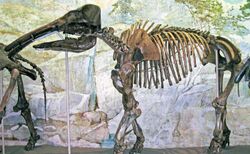Biology:Eubelodon
| Eubelodon | |
|---|---|

| |
| Skeleton | |
| Scientific classification | |
| Domain: | Eukaryota |
| Kingdom: | Animalia |
| Phylum: | Chordata |
| Class: | Mammalia |
| Order: | Proboscidea |
| Family: | †Gomphotheriidae |
| Genus: | †Eubelodon Barbour, 1914 |
| Species: | †E. morrilli
|
| Binomial name | |
| †Eubelodon morrilli Barbour, 1914
| |
Eubelodon is an extinct genus of gomphothere (a family in the order Proboscidea, which also includes modern elephants) which lived in North America during the Miocene Epoch. It contains a single species: Eubelodon morrilli.
Description
Eubelodon is considered to be a trilophodont gomphothere. It has the highly unusual combination of retaining a long lower jaw, but having lost the lower tusks, a combination only shared with fellow North American gomphothere Gnathabelodon and the choerolophodontid Choerolophodon.[1]
Fossil distribution

Fossils are restricted to what is now the Great Plains of the United States . Remains were found in the Poison Ivy Quarry, Antelope, Brown County, Nebraska, and Tripp County, South Dakota.[2]
Taxonomy
Eubelodon was named by Erwin Hinckly Barbour in 1914. It was synonymized subjectively with Trilophodon by Osborn in 1918 and again by Tobien in 1973 with Gomphotherium.[3]
It was assigned to Gomphotheriidae by Erwin Barbour in 1914. It was then assigned to Rhynchotheriinae by McKenna and Bell in 1997,[4] Carroll in 1988, Shoshani and Tassy in 1996, Lambert and Shoshani in 1998, and Shoshani and Tassy in 2005.
Taxonomic position among trilophodont Gomphotheres:[5]
†Gomphotheriidae (Gomphotheres)
|
| ||||||||||||||||||||||||||||||||||||||||||
References
- ↑ Mothé, Dimila; Ferretti, Marco P.; Avilla, Leonardo S. (12 January 2016). "The Dance of Tusks: Rediscovery of Lower Incisors in the Pan-American Proboscidean Cuvieronius hyodon Revises Incisor Evolution in Elephantimorpha". PLOS ONE 11 (1): e0147009. doi:10.1371/journal.pone.0147009. PMID 26756209. Bibcode: 2016PLoSO..1147009M.
- ↑ "Paleobiology database, Collections 18147, 18204, 18324". http://paleodb.org/cgi-bin/bridge.pl?action=displayCollResults&taxon_no=43245&max_interval=Miocene&country=United%20States&state=Nebraska&is_real_user=1&basic=yes&type=view&match_subgenera=1.
- ↑ H. Tobien. 1973. On the Evolution of Mastodonts (Proboscidea, Mammalia); Part 1, The bunodont trilophodont Groups. Notizblatt des Hessischen Landesamtes fuer Bodenforschung zu Wiesbaden 101:202-276.
- ↑ M. C. McKenna and S. K. Bell. 1997. Classification of Mammals Above the Species Level 1-640 (John Alroy and Mark Uhen, George Mason University)
- ↑ Mothé, Dimila; Ferretti, Marco P.; Avilla, Leonardo S. (12 January 2016). "The Dance of Tusks: Rediscovery of Lower Incisors in the Pan-American Proboscidean Cuvieronius hyodon Revises Incisor Evolution in Elephantimorpha". PLOS ONE 11 (1): e0147009. doi:10.1371/journal.pone.0147009. PMID 26756209. Bibcode: 2016PLoSO..1147009M.
Wikidata ☰ Q5405369 entry
 |

